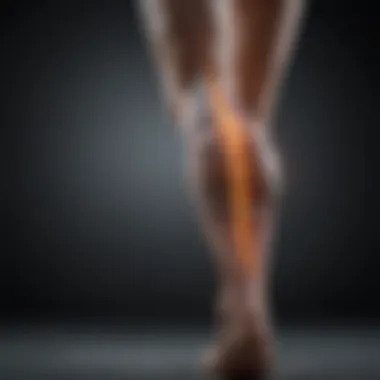Understanding Why Your Leg Falls Asleep


Intro
Experiencing a leg that falls asleep is often dismissed as a minor inconvenience. However, it reflects deeper physiological mechanisms at play. This sensation, medically known as paresthesia, is generally triggered by pressure on the nerves or blood vessels. It affects many individuals across various situations, often appearing after prolonged sitting, standing, or lying in an awkward position.
Understanding the causes and implications of this phenomenon can reveal insights into one's health. While the feeling might be temporary, it can point to underlying conditions that require attention. In this article, we will explore the various dimensions of why limbs fall asleep. We will also look into the potential long-term effects, when to seek medical help, and different strategies to improve overall leg health.
Understanding this topic is essential not just for health professionals but for anyone interested in maintaining bodily awareness and preventing issues in the future.
It is vital to note how lifestyle choices, exercise patterns, and even stress management can influence nerve health. Let's delve deeper into this phenomenon, starting with the various causes.
The Basics of Limb Sensation
Limb sensation plays a vital role in our understanding of bodily functions, particularly in medical and health contexts. When discussing the phenomenon of a leg falling asleep, it is essential to grasp the basic principles of how sensation operates within the limbs. Sensation refers to the way our body perceives stimuli through its nervous system. This includes pain, touch, temperature, and proprioception, which helps us understand our body's position. Thus, sensation is intertwined with both our health and our daily experiences.
Understanding the mechanics of limb sensation provides insight into the normal functioning of our nervous system. It also illuminates the potential disruptions that can lead to temporary or chronic numbness. This section explores the fundamental aspects of sensation that are crucial in the context of limb numbness.
- Key elements of limb sensation include:
- The role of nerve endings in detecting stimuli
- How the brain interprets signals from the body
- The pathway of nerve communication, including sensory and motor nerves
Furthermore, being aware of factors that can influence how we perceive sensation is important for recognizing abnormal symptoms. This basic comprehension can facilitate better communication with healthcare professionals, leading to improved treatment outcomes when numbness occurs.
Understanding Numbness
Numbness is often described as a loss of sensation in a specific area, frequently characterized as the feeling of "pins and needles." This sensation can arise unexpectedly, often after maintaining a particular position for too long, such as sitting cross-legged or resting against hard surfaces. In clinical terms, numbness occurs when nerve signals are compromised, either due to external pressure or underlying conditions that inhibit nerve function.
Common causes of numbness include:
- Temporary compression of nerves: This is often benign and resolves once pressure is released.
- Neurological issues: Conditions like diabetes or multiple sclerosis can lead to chronic numbness, warranting medical attention.
Numbness can indicate a range of health issues. It can stem from harmless occurrences or signal more serious conditions. Understanding numbness is crucial in determining when it might be time to consult a healthcare provider.
Factors Influencing Sensory Perception
Several factors can influence how we perceive sensation in our limbs, particularly in relation to numbness. These include:
- Posture: Prolonged postures that compress nerves can lead to the transient numbness commonly experienced when limbs are in awkward positions. The way one sits or lays can play a significant role in how blood flows and nerves communicate.
- Blood flow: Limited blood circulation can result in numbness. This can occur due to external compression or conditions such as vascular diseases.
- Temperature: Extreme temperatures can affect nerve function, resulting in altered sensory perception. Cold weather often leads to stiffness and can impair blood flow, while heat can cause swelling, both of which may influence limb sensitivity.
Understanding these influences on sensory perception is fundamental for health professionals and other wellness practitioners. It also underscores the importance of adopting healthy lifestyle choices to maintain optimal circulation and nerve function.
"Awareness of factors affecting limb sensation is essential for both proactive health management and effective patient communication."
Through the exploration of these basic principles, individuals can gain a clearer insight into their own bodies. Knowledge of limb sensation sets the foundation for recognizing signs of health issues and fosters an environment that encourages self-awareness and preventive care.
Physiology of 'Falling Asleep'
The body’s ability to experience numbness—often described in terms of having a limb that feels as if it is ‘asleep’—is a substantial aspect of human physiology. This phenomenon is essential for understanding how our body responds to various stimuli. When a limb falls asleep, it is not simply an isolated occurrence; it involves intricate interactions between nerve function, blood flow, and external pressures on the body. Each factor contributes to the larger picture of sensory perception, drawing connections to both normal physiological responses and potential medical concerns.


Nerve Function and Blood Flow
Nerve function is pivotal when we discuss the falling asleep sensation. Nerves are responsible for transmitting signals from one part of the body to another. They communicate sensory input to the brain, allowing for the perception of touch, pain, and temperature. When blood flow to a specific area is restricted, such as when sitting in one position for too long, nerves can become compressed. This compression leads to altered neurovascular function, preventing the nerves from sending signals effectively.
Blood flow plays a crucial role in maintaining nerve health. Proper circulation is necessary not only for delivering oxygen but also for removing metabolic waste from nerve tissues. Reduced blood supply can disrupt this balance, leading to numbness or tingling sensations—commonly perceived as a leg falling asleep. Immediate recovery often follows the release of pressure and restoration of blood flow, which is why many people experience a tingling sensation as the nerve function returns to normal.
Furthermore, the connection between nerve function and blood flow is not merely about temporary discomfort. Chronic issues can arise if circulation is consistently impaired or if nerves are repeatedly compressed. Managing these underlying factors is essential for preventing persistent numbness and associated complications.
The Role of Compression
Compression is another significant factor in understanding why a leg might fall asleep. It occurs when an external force constricts blood vessels or nerves, hindering their normal function. Everyday activities, such as sitting with crossed legs or propping a foot against an object, can lead to compression in the limbs. This physical pressure may obstruct blood flow and disrupt the usual signaling pathways of the nerves.
It is important to identify how long and in what positions compression affects the body. Specific postures can exacerbate the risks associated with limb numbness. Some common situations include prolonged sitting at a desk without adequate breaks, or using tight clothing that restricts circulation. Assessing posture during activities or rest periods may help in the early identification of compression-related numbness.
In summary, both nerve function and compression are integral to the physiology of falling asleep in limbs. By understanding these elements, individuals can make informed decisions about their daily habits. Recognizing the signs and implications of numbness can lead to a healthier lifestyle that minimizes discomfort.
Common Situations Leading to Numbness
Understanding the common situations that lead to numbness is crucial for both diagnosis and preventive strategies. When a limb experiences numbness, it can disrupt daily activities and raise concerns about underlying health issues. Identifying specific scenarios that contribute to this sensation allows individuals to make informed decisions about their health. As we explore these situations, it becomes clear that context matters. Certain positions or activities may exacerbate the problem, so insights into these areas can help individuals address symptoms effectively.
Maintaining Prolonged Postures
Prolonged postures are one of the leading causes of limb numbness. When an individual stays in one position for an extended period, blood flow may decrease. For instance, sitting cross-legged or resting an arm on a hard surface can compress nerves and diminish circulation. This combination leads to that familiar tingling or 'fallen asleep' feeling.
To mitigate this, it is important to frequently change positions. Simple strategies include standing up, stretching, or adjusting seating arrangements. Ergonomic solutions, like chairs designed for comfort, can also play a role in reducing the effects of long sitting. Monitoring posture is key, as good alignment can ensure nerve pathways remain unobstructed.
Physical Activity and Injury
Physical activity presents a double-edged sword. While exercise generally promotes circulation, incorrect movement or sudden injury can lead to numbness. A sports-related injury, for example, might damage surrounding tissues or compress nerves, resulting in temporary numbness.
Additionally, overexertion during workouts can strain muscles and lead to momentary nerve compression. Pay attention to body signals, as recurring numbness during specific activities may warrant adjustments in technique or intensity. It is wise to consult with a trainer if issues persist, as they can help modify routines to prevent injury while maintaining fitness.
Temperature Effects
Temperature also has a significant impact on limb sensation. Low temperatures can cause blood vessels to constrict, reducing blood flow to extremities. Cold weather is often a common trigger for numbness, particularly in the feet and hands. This physiological response aims to preserve core body heat but can leave limbs feeling numb and unresponsive.
In contrast, excessive heat can lead to swelling, which may press against nerves and create a similar sensation. Therefore, balancing thermal exposure is essential. During colder months, wearing appropriate clothing can protect against extreme temperatures. Hydration and air circulation during heatwaves help maintain comfort and reduce swelling.
Key Takeaway: Understanding these common situations leading to numbness equips readers with knowledge to recognize and address issues when they arise. Adjusting posture, being mindful of injuries, and managing temperature can all help minimize discomfort and promote better overall health.
Medical Conditions Linked to Numbness
Understanding the medical conditions that are linked to numbness is crucial for anyone experiencing this phenomenon. It extends beyond temporary discomfort to potentially indicate serious underlying issues. Acknowledging and addressing these conditions can lead to timely interventions. This section will explore various health concerns associated with numbness, illustrating their significance in helping you connect symptoms with appropriate responses.
Peripheral Neuropathy
Peripheral neuropathy is a direct consequence of damage to the peripheral nervous system. This condition causes symptoms like numbness, tingling, and weakness, primarily in the extremities. There are numerous causes of peripheral neuropathy, including toxic exposures, chemotherapy, alcohol abuse, and, most often, diabetes. The damage to nerves essentially disrupts communication between the brain and the rest of the body, leading to sensations commonly described as "limb falling asleep."


Recognizing peripheral neuropathy is important. Early detection allows for better management of the condition and can prevent severe disability. Health professionals often recommend regular screenings for individuals at risk, especially those with diabetes or autoimmune disorders. The identification of peripheral neuropathy can help guide treatment plans, including medications, physical therapy, and lifestyle modifications.
Diabetes and Its Impact
Diabetes significantly impacts nerve health, often resulting in a condition known as diabetic neuropathy. Elevated blood sugar levels can lead to nerve damage over time, manifesting as numbness, especially in the feet and legs. If left unchecked, diabetic neuropathy could lead to serious complications, including infections and amputations, highlighting the importance of managing blood sugar levels effectively.
Patients with diabetes should be vigilant for symptoms of numbness and seek medical advice promptly. Regular consultation with healthcare providers allows for ongoing monitoring and adjusted treatment strategies to mitigate complications. Emphasizing stable blood glucose levels and proper foot care can significantly reduce the risk of developing further nerve damage related to diabetes.
Multiple Sclerosis and Other Neurological Disorders
Multiple Sclerosis (MS) is a chronic illness that affects the central nervous system, leading to a wide range of symptoms, including numbness. In MS, the immune system mistakenly attacks the protective sheath covering nerve fibers, impeding effective communication between the brain and various parts of the body. Numbness in the limbs can occur intermittently and serve as a key indicator for clinicians in diagnosing this complex illness.
Other neurological disorders can also produce similar symptoms, making the recognition of numbness a critical factor for healthcare professionals. Conditions like amyotrophic lateral sclerosis (ALS) or Guillain-Barré syndrome can emerge with numbness alongside other neurological signs. Early intervention can help manage these diseases and ameliorate symptoms. Therefore, understanding these connections between numbness and specific diseases allows individuals to be more aware of their health and seek timely medical intervention.
Monitoring health and discussing concerns with a healthcare provider can lead to early diagnosis and better outcomes for those experiencing numbness.
Overall, recognizing the medical conditions associated with numbness is vital. Being proactive by consulting healthcare professionals upon experiencing symptoms can ensure appropriate management and treatment.
When to Seek Medical Attention
Understanding when to seek medical attention for limb numbness is crucial for maintaining overall health. While occasional numbness can be common and benign, persistent or severe symptoms may indicate more serious conditions. Recognizing the right moment to consult health care professionals can lead to effective management and treatment, preventing complications if there are underlying issues.
Identifying Warning Signs
Several warning signs can indicate the need for medical advice. These may include:
- Persistent Numbness: If numbness lasts more than a few minutes, it is advisable to seek help.
- Accompanied Symptoms: Numbness that occurs with weakness, vision changes, or difficulty speaking should be taken seriously.
- Injury or Trauma: If numbness follows an injury, immediate assessment may be necessary to rule out nerve damage.
- Frequent Episodes: If you experience numbness regularly, tracking the frequency and duration can provide valuable information to your healthcare provider.
Recognizing these signs may prompt an earlier consultation, potentially leading to better outcomes.
Consultation with Healthcare Professionals
When discussing numbness, approaching a healthcare professional can provide clarity. During the consultation, practitioners may perform a thorough examination. This includes:
- Medical History Review: A careful look into past medical conditions, lifestyle factors, and current medications can uncover potential causes of numbness.
- Physical Examination: A hands-on assessment helps to identify any physical abnormalities that may contribute to sensory changes.
- Diagnostic Tests: If necessary, tests such as MRIs, CT scans, or nerve conduction studies might be suggested to provide detailed insights into the underlying causes.
This collaborative process not only aids in identifying the source of your symptoms but helps in developing appropriate strategies for alleviation. Open communication with your healthcare provider is key to understanding your body’s signals and taking informed actions.
Preventive Measures and Best Practices
Preventive strategies can greatly reduce the frequency and intensity of leg numbness. Understanding these measures not only empowers individuals to take control of their wellness, but also helps in mitigating the effects caused by physical inactivity or poor habits. This section examines various best practices, focusing on mindful posture, circulation enhancement, and the significance of regular health check-ups.
Mindful Posture and Movement
Occupational habits and daily activities often promote poor posture, leading to nerve compression and restricted blood flow. Being conscious of one's posture is vital for maintaining good limb sensation.
- Awareness: Regularly assess posture during sitting, standing, or any movements. This creates a mind-body connection that may help in avoiding awkward positions.
- Ergonomics: Use ergonomic furniture and tools. For instance, a chair with lumbar support can help keep a healthy spine alignment, reducing undue pressure on nerves.
- Frequent Breaks: Especially for individuals in sedentary jobs, taking short breaks to stretch and change positions can improve circulation. This is critical to prevent stiffness and encourage proper blood flow.


The practice of mindful posture is not just about comfort. It's about creating an environment that fosters good health.
Enhancing Circulation
Good circulation is fundamental to nerve health and sensation in the limbs. Strategies to enhance circulation are necessary for overall well-being.
- Exercise: Engage in regular physical activities. Even light exercises like walking can boost circulation. Aim for at least 30 minutes of moderate activity most days.
- Hydration: Ensure adequate fluid intake. Dehydration can lead to poor circulation, which might contribute to numbness.
- Warm Compresses: Applying heat to certain body areas can help improve blood flow. Warmth encourages veins and arteries to expand, allowing better oxygenation of tissues.
These circulation strategies can be easily integrated into daily routines, making them simple yet effective.
Regular Healthcare Check-ups
Routine health screenings can identify any underlying conditions that might contribute to numbness. Keeping a proactive approach to healthcare is essential.
- Specialist Visits: Regular visits to a neurologist or primary care physician can help monitor potential problems such as neuropathy.
- Blood Tests: Conditions like diabetes or vitamin deficiencies can often be detected early via blood tests. Early detection is key to managing any related symptoms like leg numbness.
- Lifestyle Assessment: Discuss lifestyle habits with healthcare professionals. They can provide personalized advice that aligns with individual health needs.
By maintaining regular check-ups, individuals can stay ahead of issues that may contribute to numbness, ensuring a better quality of life.
"Understanding and acting on the body's signals can significantly improve health outcomes."
Understand Your Body's Signals
Understanding how your body communicates its needs and issues is crucial for overall health, particularly in addressing the phenomenon of leg numbness. This section focuses on the significance of recognizing physical sensations, specifically those indicating numbness or discomfort in the limbs. The body often sends signals that, when interpreted correctly, can lead to timely interventions and prevent further complications.
Physical responses such as numbness should not be dismissed. They may be the initial signs of underlying conditions that warrant attention. By learning to listen to these signals, individuals can take proactive steps to mitigate risks. This awareness fosters a deeper connection to one's own well-being, empowering individuals to react before small issues escalate into more severe health problems.
Listening to Physical Responses
Listening to your body's physical responses is vital in understanding your health. Numbness in a leg may arise suddenly, or it could develop gradually, indicating different potential causes. Acknowledging when a sensation of numbness occurs can provide insight into its origins.
- Identify Triggers: Take note of when leg numbness occurs. Is it after sitting in one position for too long? Or does it happen after intense workouts? Understanding the pattern helps in addressing the root causes.
- Monitor Duration: Consider how long numbness lasts. Temporary numbness often resolves with movement. However, if it persists, it could signal a more serious condition.
- Document Changes: Keeping a health diary can be useful. Record experiences regarding your leg sensations to create a clearer picture of your health trends.
"Listening to your body is not just about reacting, but also understanding the language it speaks."
Recognizing these signals is the first step to proper self-care and can guide you to seek medical advice when necessary.
Integrating Self-Care into Daily Life
Integrating self-care practices into daily routines is essential to maintain proper bodily function and enhance overall well-being. For numbness in the legs, small lifestyle adjustments can lead to significant improvements in limb health.
- Regular Movement: Incorporate walks, stretches, or workouts that improve circulation. Simple exercises targeting lower extremities can stimulate blood flow.
- Mindful Posture: Pay attention to your posture while sitting or standing. Correcting posture can reduce pressure on nerves, thereby decreasing instances of numbness.
- Stay Hydrated: Adequate hydration plays a role in maintaining nerve health. Drinking sufficient water is a straightforward yet impactful self-care practice.
Prioritizing these self-care practices demonstrates an effective approach to listening to and nurturing your body. In doing so, you can significantly reduce the recurrence of numb sensations and foster a healthier lifestyle.
Ending
Summarizing Key Points
In summary, the key points articulated in this article include:
- Understanding Sensation: Recognizing the difference between numbness and other sensory changes is crucial. The article elucidates how the nervous system and blood flow respond in unique ways.
- Physiological Mechanisms: Various physiological factors contribute to the experience of leg numbness, such as nerve compression and changes in blood circulation. Understanding these processes helps demystify why we experience these sensations.
- Common Situations: The article highlights situations that lead to numbness, like prolonged sitting or certain physical activities. Such knowledge is essential for developing strategies to avoid discomfort.
- Medical Conditions: Awareness of medical conditions that correlate with numbness, including peripheral neuropathy and diabetes, is significant for early detection and intervention.
- Seeking Medical Help: Knowing when to seek professional advice is essential. The article provides detailed guidance on warning signs requiring medical consultations.
- Prevention and Self-Care: The discussion on preventive measures underlines the importance of posture, circulation, and routine health assessments.
Final Thoughts on Leg Numbness
Important Note: Regular check-ups and mindful movement are key components in managing and understanding leg numbness.







